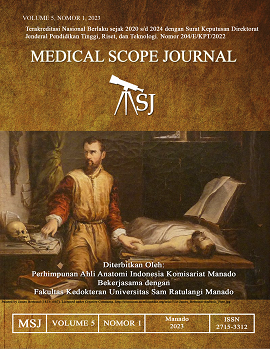Penggunaan Opioid-Free Anaesthesia (OFA): Laporan Kasus
DOI:
https://doi.org/10.35790/msj.v5i1.47644Abstract
Perioperative use of opioids has many detrimental effects on health care outcomes and is currently accelerating the worldwide epidemic of opioid addiction prescription and overdose death. Due to the excessive use of opioids and their side effects, a new strategy was developed in order to achieve a balanced general anesthesia, namely opioid-free anesthesia (OFA). This technic can be used in most surgeries using alternative analgesic drugs. We reported a female patient, 59 years old, referred to the Department of Anesthesia from the Department of Surgery for elective thyroidectomy. The patient was diagnosed as ASA 3, Actual: difficult airway, subclinical hyperthyroidism, drug allergy, controlled hypertension (with amlodipine 10 mg); Potential: difficult intubation. We used general anasethesia with endotracheal tube, premedication with midazolam 2 mg iv, analgesic with dexme-detomidine 0.1 mcg /kg BW worn out in 10 minutes. The operation went smoothly and on the 2nd day after surgery, the patient was transferred to the regular ward. In conclusion, the use of non-opioid anesthetic drugs is an effective and rational choice in order to reduce the side effects of postoperative opioids in this patient.
Keywords: anesthesia; opioid-free; hyperthyroid
Abstrak: Penggunaan opioid perioperatif memiliki banyak efek merugikan pada hasil perawatan kesehatan dan saat ini mempercepat epidemi kecanduan peresepan opioid dan kematian akibat overdosis di seluruh dunia. Oleh karena penggunaan opioid yang berlebihan dan efek sampingnya, maka dikembangkanlah suatu strategi baru dalam rangka mencapai anestesi umum yang seimbang yaitu opioid-free anaesthesia (OFA). Teknik ini dapat digunakan pada sebagian besar operasi dengan memakai obat analgesik alternatif. Kami melaporkan seorang pasien perempuan, 59 tahun, dirujuk ke Bagian Anestesi dari Bagian Bedah untuk operasi elektif tiroidektomi. Diagnosis pasien ini ialah ASA 3, Aktual: difficult airway, hipertiroid subklinis, alergi obat, hiperetensi terkontrol (amlodipin 10 mg); Potensial: sulit intubasi. Teknik anestesi ialah general anaesthesia (GA) dengan endotracheal tube (ETT), dengan premedikasi midazolam 2 mg iv, analgetik dexmedetomidine 0,1 mcg/kg BB habis dalam 10 menit. Operasi berjalan lancar dan pada hari kedua pasca bedah, pasien dipindahkan ke ruang rawat biasa. Simpulan studi ini ialah penggunaan obat anestesi non-opiod merupakan pilihan yang efektif dan rasional dalam rangka mengurangi efek samping opioid paska operasi pada pasien ini.
Kata kunci: anestesi; bebas opioid; hipertiroid
References
Basto T, Machado HS. Effect of opioid-free anaesthesia on perioperative period: a review. Int J Anesthetic Anesthesiol. 2020;7(2):104.
Koyuncu O, Urfali S, Turhanoglu S. Opioid free anesthesia. World J Surg Surgical Res. 2022;5:1395.
Thota RS, Ramkiran SS, Garg R., Goswami J, Baxi V, Thomas M. Opioid free onco anesthesia: is it time to convict opioids? A systematic review of literature. J Anaesthesiol Clin Pharmacol. 2019;35(4): 441-52.
Siu EY, Moon TS. Opioid-free and opioid-sparing anesthesia. Int Anesthesiol Clin. 2020;58(2):34-41.
Sultana A, Torres D, Schumann R. Special indications for OFA, patient and procedure related. Best Pract Res Clin Anesthesiol. 2017;31(4):547-60.
Toleska M, Kuzmanovska B, Kartalov A, Shosholcheva M, Nancheva J, Dimitrovski A, et al. Opioid free anesthesia for laparotomic hemicolectomy: a case report. Pril (Makedon Akad Nauk Umet Odd Med Nauki). 2018;39(2-3):121-6. Doi: 10.2478/prilozi-2018-0050.
Egan TD. Are opioids indispensable for general anaesthesia? Br J Anaesth. 2019;122(6): e127–e135.
Koepke EJ, Manning EL, Miller TE, Ganesh A, Williams DGA, Manning MW. The rising tide of opioid use and abuse: the role of the anesthesiologist. Perioper Med. 2018;7:16. Doi: 10.1186/s13741-018-0097-4.
Beloeil H. Opioid-free anesthesia. Best Pract Res. Clin Anaesthesiol. 2019;33(3):353–60. Doi: 10.1016/j.bpa.2019.09.002.
Chia PA, Cannesson M, Bui CCM. Opioid free anesthesia: feasible? Curr Opin Anaesthesiol. 2020; 33(4):512–7.
Salomé A, Harkouk H, Fletcher D, Martinez V. Opioid-free anesthesia benefit–risk balance: a systematic review and meta-analysis of randomized controlled trials. J Clin Med. 2021;10(10):2069. Available from: https://doi.org/10.3390/jcm10102069
Ghai B, Jafra A, Bhatia N, Chanana N, Bansal D, Mehtaet V. Opioid sparing strategies for perioperative pain management other than regional anaesthesia: a narrative review. J Anaesthesiol Clin Pharmacol. 2022;38(1):3-10.
Brown EN, Pavone KJ, Naranjo M. Multimodal general anesthesia: theory and practice. Anesth Analg 2018;127(5) :1246–58.
Mulier JP. Perioperative opioids aggravate obstructive breathing in sleep apnea syndrome: mechanisms and alternative anesthesia strategies. Curr Opin Anesthesiol. 2016;29(1):129–33.
Patil SK, Anitescu M. Opioid-free perioperative analgesia for hemicolectomy in a patient with opioid-induced delirium: a case report and review of the analgesic efficacy of the alpha-2 agonist agents. Pain Pract. 2012;12(8):656–62.
Downloads
Published
How to Cite
Issue
Section
License
Copyright (c) 2023 Mordekhai L. Laihad, Livy A. Rarung, Hizkia B. Rumampuk

This work is licensed under a Creative Commons Attribution-NonCommercial 4.0 International License.
COPYRIGHT
Authors who publish with this journal agree to the following terms:
Authors hold their copyright and grant this journal the privilege of first publication, with the work simultaneously licensed under a Creative Commons Attribution License that permits others to impart the work with an acknowledgment of the work's origin and initial publication by this journal.
Authors can enter into separate or additional contractual arrangements for the non-exclusive distribution of the journal's published version of the work (for example, post it to an institutional repository or publish it in a book), with an acknowledgment of its underlying publication in this journal.
Authors are permitted and encouraged to post their work online (for example, in institutional repositories or on their website) as it can lead to productive exchanges, as well as earlier and greater citation of the published work (See The Effect of Open Access).










